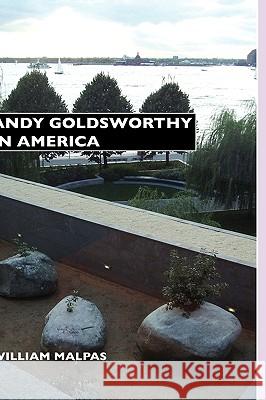Andy Goldsworthy in America » książka
Andy Goldsworthy in America
ISBN-13: 9781861712509 / Angielski / Twarda / 2010 / 344 str.
ANDY GOLDSWORTHY IN AMERICA
This study looks at the contemporary British artist, Andy Goldsworthy, and his work in the United States of America. Goldsworthy's presence in America grew steadily with a series of exhibitions beginning in the late Nineties with the Storm King Wall and show. This was followed by: Cornell University in 2000; the Three Cairns show and installations in 2002-03; Austin Museum in 2003; the Garden of Stone and Stone Houses in New York City in 2003-04; and Roof in Washington in 2005.
There are a number of essential sites to visit for Andy Goldsworthy's art in America: (1) the slate mounds in Washington's National Gallery of Art; (2) Garden of Stones in New York's Museum of Jewish Heritage; (3) the cracked stones at the de Young Museum in San Francisco; (4) the Storm King Wall in New York; and (5) Three Cairns in Des Moines, Iowa.
Fully illustrated, including images of the American landscape, and Goldsworthy's contemporaries.
Includes photographs taken by the author of Andy Goldsworthy's works in America, including in Washington, DC, San Francisco, New York State and Iowa.
Bibliography and notes.
WILLIAM MALPAS has written books on Richard Long and land art, as well as three books on Andy Goldsworthy, including the forthcoming Andy Goldsworthy In America. Malpas's books on Richard Long and Andy Goldsworthy are the only full-length studies of these artists available. EXTRACT
Andy Goldsworthy works with the natural world, and within nature. He uses natural materials in natural shapes and forms set in natural contexts. Goldsworthy takes his cue from nature: as Jan Dibbets put it in 1969: 'I realized that if you want to use nature, you have to derive the appropriate structure from nature too'. Nature may be the starting-point but, as we'll see, the end-point - art - is entirely cultural and not something you'll ever find in the natural world.
Andy Goldsworthy seems to be a particularly gentle and sensitive artist, compared to many sculptors and land artists: he stitches together leaves to form lines (which're often placed in water, or over branches), or makes circular slabs of snow, or entwines twigs in an arc. He creates a delicate spiral of chestnut leaves, called Autumn Horn (1986); he pins bright yellow dandelions on willowherb stalks in a circle, on bluebells (1987); he makes lines and cairns of pebbles; a horizontal line of red sumach leaves was pinned to a willow (at Storm King in 1998); he rubs red stones to stain rockpools; he pins leaves to tree trunks; he fashions a zigzag line of hogweed stalks along a fallen elm tree (2002); he makes hollow, circular structures, recalling igloos, from slate, leaves, driftwood and bracken; he creates long wavy ridges in Arizonan and Australian desert sand; he throws sand and sticks in the air and photographs the moment.
ANDY GOLDSWORTHY IN AMERICA
This study looks at the contemporary British artist, Andy Goldsworthy, and his work in the United States of America. Goldsworthys presence in America grew steadily with a series of exhibitions beginning in the late Nineties with the Storm King Wall and show. This was followed by: Cornell University in 2000; the Three Cairns show and installations in 2002-03; Austin Museum in 2003; the Garden of Stone and Stone Houses in New York City in 2003-04; and Roof in Washington in 2005.
There are a number of essential sites to visit for Andy Goldsworthys art in America: (1) the slate mounds in Washingtons National Gallery of Art; (2) Garden of Stones in New Yorks Museum of Jewish Heritage; (3) the cracked stones at the de Young Museum in San Francisco; (4) the Storm King Wall in New York; and (5) Three Cairns in Des Moines, Iowa.
Fully illustrated, including images of the American landscape, and Goldsworthys contemporaries.
Includes photographs taken by the author of Andy Goldsworthys works in America, including in Washington, DC, San Francisco, New York State and Iowa.
Bibliography and notes.
WILLIAM MALPAS has written books on Richard Long and land art, as well as three books on Andy Goldsworthy, including the forthcoming Andy Goldsworthy In America. Malpass books on Richard Long and Andy Goldsworthy are the only full-length studies of these artists available.
EXTRACTAndy Goldsworthy works with the natural world, and within nature. He uses natural materials in natural shapes and forms set in natural contexts. Goldsworthy takes his cue from nature: as Jan Dibbets put it in 1969: I realized that if you want to use nature, you have to derive the appropriate structure from nature too. Nature may be the starting-point but, as well see, the end-point - art - is entirely cultural and not something youll ever find in the natural world.
Andy Goldsworthy seems to be a particularly gentle and sensitive artist, compared to many sculptors and land artists: he stitches together leaves to form lines (whichre often placed in water, or over branches), or makes circular slabs of snow, or entwines twigs in an arc. He creates a delicate spiral of chestnut leaves, called Autumn Horn (1986); he pins bright yellow dandelions on willowherb stalks in a circle, on bluebells (1987); he makes lines and cairns of pebbles; a horizontal line of red sumach leaves was pinned to a willow (at Storm King in 1998); he rubs red stones to stain rockpools; he pins leaves to tree trunks; he fashions a zigzag line of hogweed stalks along a fallen elm tree (2002); he makes hollow, circular structures, recalling igloos, from slate, leaves, driftwood and bracken; he creates long wavy ridges in Arizonan and Australian desert sand; he throws sand and sticks in the air and photographs the moment.











